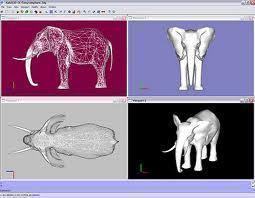3D Graphics
3 dimensional, or 3D Graphics are a representation of an object displayed in three dimensions (length, depth and height). The creation of 3-D graphics can be divided into three phases. The first step, defines the shape of the object in a process called 3D modeling. The second step involves the placement and motion of the objects in a step called layout and animation, and the last step renders the final image of the object.
3D Modeling
3D modeling involves making the basic three-dimensional shape or wire frame of the objects. This can be done through different methods like scanning the shape of a real-world object into a computer using 3D modeling tools, procedural modeling using a set of algorithms or physical/dynamical simulation.
3D modeling is used by most industries today such as the medical industry for a detailed presentation of organs, the entertainment industry for its video and computer games, the movie industry for visual effects, and the engineering industry for 3D rendering of new devices, building plans or vehicle designs.
The modeling process can either be through polygonal modeling in which dots are connected and the faces of the polygons that result create the image of the object. It can also be through NURBS modeling where dots are used again but curved lines are used to connect them and create the image.
Lay-Out and Animation
This step involves placing the object within a scene. Here, the spatial relationships of the objects that are to be in the same scene are defined and factors like location and size are taken into account. Some of the commonly used methods for this step are motion capture or digital recording of movements, inverse kinematics or determining the proper angular positions of the elements of a jointed object, and keyframing, which defines the start and endpoints of a smooth transition through frames.
Movement in this step is created by displaying a series of images that are similar to one another on the screen in a sequential fashion to create the illusion of movement. The frames can be replaced by a virtual skeleton and the computer automatically calculates the differences in appearance among succeeding frames by a process known as morphing or tweening.
Rendering
Rendering is the step wherein the model is translated into an image by integrating lighting effects such as shadows and scattering of light. Today, one of the popular reflection models used in 3D graphics rendering is the Phong reflection model. This determines how the light is reflected or refracted from a surface at any given point in the object and how the properties of the object materials vary on said surface. Several techniques are used to create this effect and some of them are: flat shading, Gouraud shading, texture mapping, Phong shading, Cel shading and bump shading.
3D computer graphics software is used in this step to enable the 3D projection of the image. Different rendering methods include scanline rendering, radiosity, ray tracing and wireframe rendering.


Comments - No Responses to “3D Graphics”
Sorry but comments are closed at this time.